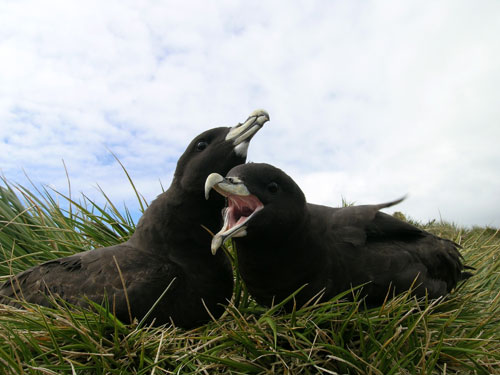Peter Ryan, Ben Dilley and Genevieve Jones of the University of Cape Town's FitzPatrick Institute have published in the journal Polar Biology on the numbers of ACAP-listed White-chinned Petrels Procellaria aequinoctialis breeding at the Prince Edward Islands.
The paper's abstract follows:
"The white-chinned petrel (Procellaria aequinoctialis) is the seabird most often killed on longlines in the Southern Ocean and is listed as vulnerable to extinction. We estimated the population breeding at the Prince Edward Islands, the last breeding site for the nominate subspecies that lacks a recent population estimate. White-chinned petrel burrows are largely confined to deep, muddy soils, usually on slopes below 200 m, but locally up to 420 m. After correcting for count bias, Marion Island has an estimated 29,900 nests (95 % CI 27,700-32,400). Burrow occupancy rates at the start of the incubation period were 65 % during one-off surveys, but repeat surveys found that at least 73 % of burrows were occupied and 87 % of burrows showed signs of occupancy. This suggests that there were roughly 24,000 occupied nests on Marion Island (95 % CI 20,000-28,000). A more cursory survey on Prince Edward Island yielded 14,700 burrows, suggesting that there are 9,000-15,000 occupied nests. The nominate subspecies of white-chinned petrel occupies approximately 974,200 nests (95 % CI 678,000-1,286,000), with the Prince Edward Islands, the third most important breeding site, after South Georgia and Kerguelen. Assuming that populations breeding at islands in the Atlantic and Indian Oceans winter in different regions, the impact of fishery bycatch is likely to have had a greater impact on the Indian Ocean population. The Marion Island survey provides a baseline against which future population changes can be assessed."

A pair of White-chinned Petrels call together. Photograph by Ben Phalan
References:
Percy FitzPatrick Institute 2011. 30000 holes on Marion Island. Africa Birds & Birding 16(1): 22.
Ryan, P.G., Dilley, B.J. & M. G. W. Jones, M.G.W. 2012. The distribution and abundance of white-chinned petrels (Procellaria aequinoctialis) breeding at the sub-Antarctic Prince Edward Islands. Polar Biology. DOI 10.1007/s00300-012-1227-y.
John Cooper, ACAP Information Officer, 23 August 2012

 Français
Français  English
English  Español
Español